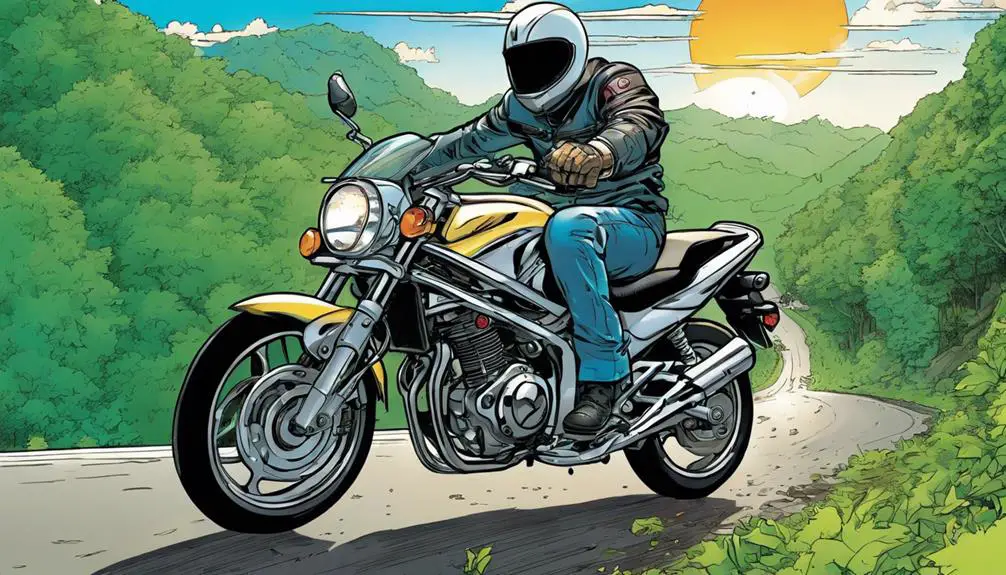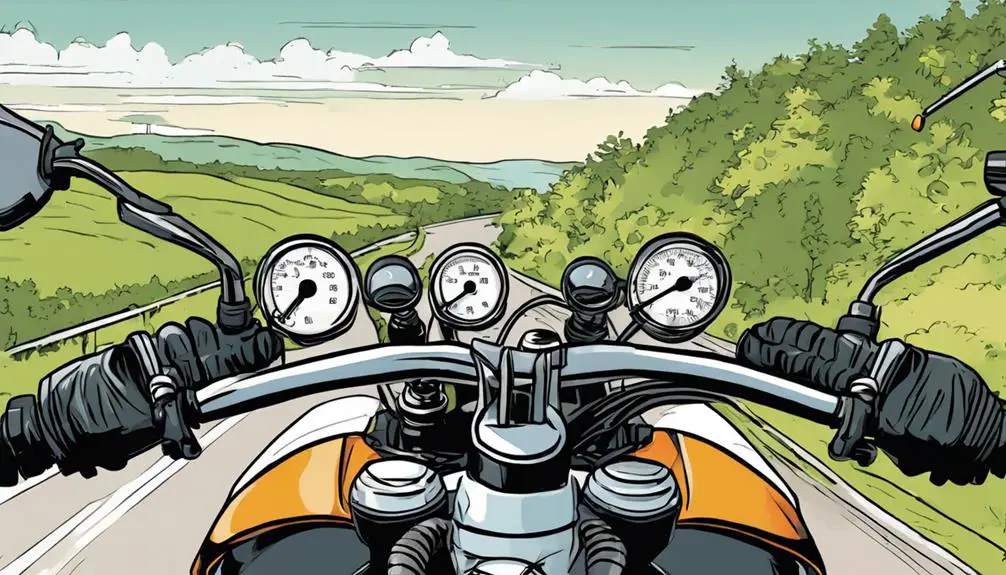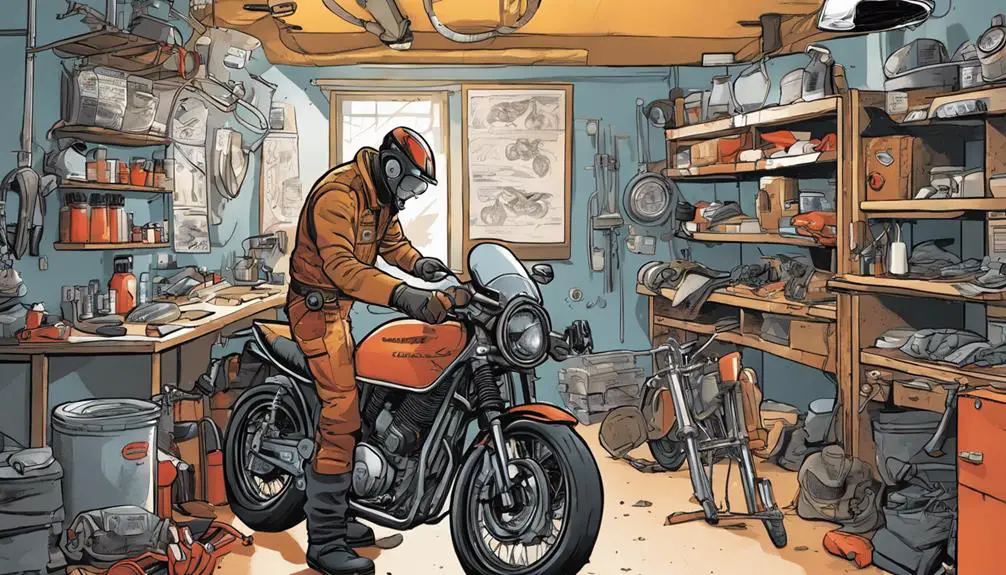You might be surprised to learn that many beginner-friendly motorcycles come equipped with features that can greatly reduce the risk of accidents. These bikes are designed with a focus on stability and control, making them easier for new riders to handle. But what specific elements contribute to their safety? Understanding the technology and design choices behind these motorcycles can offer valuable insights into how they support novice riders on the road.
Quick Takeaways
- Lightweight designs allow for easier handling, reducing fatigue and boosting beginners' confidence while mastering balance.
- Low seat heights enhance stability at stops, improving control and maneuverability for new riders.
- Advanced safety features like ABS and traction control provide better grip and stability during challenging conditions.
- User-friendly controls with intuitive layouts minimize strain, allowing beginners to focus on enjoying the ride.
Suzuki Motorcycle Safety Features

When considering a safe ride for beginners, Suzuki motorcycles offer a range of advanced safety features designed to enhance your riding experience.
You'll appreciate the Antilock Braking System (ABS), which prevents wheel lock-up during sudden stops, giving you more control and stability in unexpected situations. This feature empowers you, allowing you to ride with confidence, even in tricky weather conditions.
Another standout is the Low RPM Assist, which helps maintain a smooth engine idle, preventing stalling when you're starting from a stop. This makes maneuvering through city traffic a breeze, so you can focus on enjoying the freedom of the open road.
Additionally, Suzuki's lightweight frame and low center of gravity enhance maneuverability, allowing you to easily handle turns and tight spaces.
The brand also incorporates bright LED lighting for better visibility, ensuring you can be seen by others, especially at night.
With these safety features, you'll feel liberated as you ride, knowing you have the technology to support your journey.
Suzuki motorcycles blend performance with safety, making them a powerful choice for those ready to begin their thrilling adventure.
Beginner-Friendly Models
When you're starting out, choosing a motorcycle that's lightweight can really boost your confidence and control.
A low seat height helps you plant your feet firmly on the ground, making stops much easier.
Plus, user-friendly controls guarantee you can focus on the road instead of fumbling with complicated features.
Lightweight Design Benefits
Lightweight motorcycles offer new riders enhanced maneuverability and control, making them ideal for building confidence on the road. When you hop on a lighter bike, you'll feel the difference immediately. You can navigate tight corners and busy streets with ease, allowing you to focus on honing your skills instead of wrestling with the machine.
Here are a few benefits of lightweight designs:
- Easier Handling: A lighter bike responds quickly to your inputs, which is essential for new riders still mastering balance and coordination.
- Reduced Fatigue: You won't tire out as quickly during long rides, which means you can enjoy the freedom of the open road without feeling drained.
Choosing a motorcycle with a lightweight design sets you up for success. You'll embrace every twist and turn with excitement, knowing that your bike is there to support you as you explore your newfound passion for riding.
Low Seat Height
Designed with beginners in mind, motorcycles featuring a low seat height make it easier for new riders to reach the ground and maintain stability at stops. This essential aspect boosts your confidence, allowing you to feel grounded and secure as you navigate urban streets or winding country roads.
A low seat height means you can effortlessly plant your feet, enhancing your ability to balance the bike when the ride gets tricky. When you ride a motorcycle with a lower seat, you can focus more on enjoying the freedom of the open road rather than worrying about tipping over.
It empowers you to maneuver through traffic and tackle tight corners with less anxiety. Plus, it gives you a sense of control, which is critical when you're just starting out.
Models like the Honda Rebel or the Kawasaki Z125 Pro exemplify this feature, offering a comfortable ride without sacrificing style. So, if you're craving that exhilarating sense of adventure, choosing a bike with a low seat height will help you embrace your journey with confidence.
Your liberation on two wheels starts here, and the right bike can make all the difference.
User-Friendly Controls
User-friendly controls are often found in beginner-friendly motorcycle models, making it easier for new riders to navigate their first experiences on two wheels. These motorcycles prioritize simplicity, allowing you to focus on the road ahead rather than fumbling with complex mechanisms.
Key features of user-friendly controls include:
- Intuitive Layout: Everything's positioned just right, so you can quickly reach the throttle, brakes, and clutch without stretching or straining.
- Smooth Engagement: Controls are designed for easy operation, ensuring that your throttle response and braking feel natural, reducing the risk of overreacting in tricky situations.
With these features, you'll feel more in control and confident as you ride. The simplicity of user-friendly controls empowers you to embrace the freedom of the open road without the anxiety of complex systems.
As a beginner, you deserve a motorcycle that enhances your experience, allowing you to truly enjoy the liberation that comes with riding. Choose wisely, and let your journey begin!
Safety Ratings Overview

When choosing your first motorcycle, understanding safety ratings is essential.
You'll want to look at crash test ratings, stability features, and rider assistance technologies to guarantee your ride is as safe as possible.
These elements can make a significant difference in your overall experience on the road.
Crash Test Ratings
Crash test ratings play an essential role in helping you choose a safe motorcycle by evaluating how well different models protect riders in various crash scenarios. These ratings provide vital insights that can guide your decision, ensuring you feel confident and secure on your ride.
When looking at crash test ratings, consider these key factors:
- Impact Absorption: The motorcycle's ability to absorb energy during a collision can greatly reduce injury risk.
- Structural Integrity: A strong frame and quality materials can enhance rider protection when accidents occur.
Stability Features Explained
Understanding stability features is just as important as examining crash test ratings, as these elements greatly contribute to a motorcycle's overall safety and handling. When you're out on the open road, you want a bike that feels solid beneath you.
One key aspect is the motorcycle's frame design. A well-engineered frame enhances rigidity, allowing you to maneuver with confidence, especially at higher speeds or sharp turns.
Another essential element is the wheelbase length. A longer wheelbase typically offers better stability, which is crucial for beginners still mastering balance. Plus, the weight distribution plays a significant role; a lower center of gravity can help you feel more grounded, making it easier to control your ride.
Tire quality shouldn't be overlooked either. Good tires provide the grip you need to maintain control and stability on various surfaces.
Rider Assistance Technologies
Offering a suite of advanced safety features, rider assistance technologies can greatly enhance your confidence and control on the road.
These innovations are designed to support you in maneuvering challenging conditions, ensuring you feel empowered rather than restricted.
Some key rider assistance technologies include:
- Anti-lock Braking System (ABS): This prevents wheel lock-up during hard braking, helping you maintain control.
- Traction Control: This system helps you avoid losing grip on slippery surfaces, enhancing stability.
Historical Safety Improvements
Since the inception of motorcycles, manufacturers have continuously enhanced safety features to protect riders and reduce accidents. Over the years, advancements in materials and design have revolutionized how you experience riding. Early models lacked basic safety provisions, but innovations like stronger frames and better braking systems emerged to bolster your confidence on the road.
The introduction of anti-lock braking systems (ABS) marked a significant shift, allowing you to maintain control during emergency stops. Additionally, improvements in tire technology have provided better grip and stability, vital for maneuvering diverse terrains. Helmets have also evolved, with lighter materials and advanced cushioning, ensuring that your head is well-protected without sacrificing comfort.
In the quest for liberation, you'll find that safety doesn't limit your freedom; it enhances your riding experience. With the incorporation of features like traction control and stability management, you can focus on the thrill of the ride, knowing you're equipped with tools that prioritize your safety.
These historical safety improvements not only empower you but also inspire confidence as you embrace the open road, making your journey as exhilarating as it's secure.
Common Problems and Solutions

As a beginner rider, you might encounter several common problems that can affect your experience, but knowing how to address them will keep you safe and confident on the road.
Recognizing these issues early can prevent bigger headaches down the line. Here are three common problems and their solutions:
- Flat tires: Always check your tire pressure before hitting the road. If you notice a flat, learn how to patch it or call for roadside assistance.
- Electrical issues: If your motorcycle won't start, it could be a dead battery. Keep a portable charger handy or learn how to jump-start your bike to get going again.
Tips for Safe Riding
Recognizing common problems is just the first step; implementing safe riding practices is essential to enjoying your time on the road. To embrace the freedom of the open highway, start by always wearing your gear. A good helmet, gloves, and jacket can save your skin in unexpected situations.
Next, stay aware of your surroundings. Keep your eyes moving and scan for potential hazards—cars, pedestrians, or potholes. This heightened awareness will help you react swiftly when needed.
Practice defensive riding. Anticipate the actions of other drivers and position yourself for maximum visibility. Don't ride in blind spots; use your mirrors often to stay informed about what's around you.
Moreover, take it slow. It's tempting to push your limits, but mastering your motorcycle at a comfortable pace is vital. Gradually build your confidence and skills.
Common Questions
What Is the Average Price Range for Beginner Motorcycles?
When you're looking for a beginner motorcycle, you'll typically find prices ranging from $4,000 to $10,000.
Factors like brand, model, and features influence the cost. You might also consider used options, which can save you money while still providing a great ride.
Don't forget to factor in gear and insurance, as those can add to your overall expenses.
Explore your options, and you'll find a bike that fits your budget and spirit!
How Does Motorcycle Weight Affect Beginner Safety?
You might think heavier motorcycles offer more stability, but they can actually hinder your control as a beginner.
Lighter bikes allow you to maneuver easily, making it simpler to handle unexpected situations.
When you're starting out, having a bike that you can easily lift and control boosts your confidence and enhances your safety.
Choosing a motorcycle with manageable weight helps you feel liberated, empowering you to focus on mastering your riding skills.
Are There Specific Gear Recommendations for New Riders?
When you start riding, investing in the right gear is essential. You should prioritize a good-quality helmet that meets safety standards, as it protects your head in case of falls.
Consider a durable jacket with armor, gloves for grip, and sturdy boots that cover your ankles. Don't forget about protective pants, too.
This gear not only boosts your safety but also helps you feel more confident and liberated on the road. Enjoy the ride!
What Types of Licenses Are Needed for Beginner Motorcycles?
Ready to hit the open road?
To ride a beginner motorcycle, you typically need a motorcycle learner's permit or a full motorcycle license, which varies by state. Many places require you to pass a written test and a practical riding exam.
These licenses aren't just bureaucratic hurdles; they empower you with essential skills and knowledge, ensuring you embrace your newfound freedom safely.
How Can Beginner Riders Build Confidence on the Road?
To build confidence on the road, start by practicing in low-traffic areas where you feel comfortable.
Gradually increase your exposure to different road conditions and traffic scenarios.
Take a safety course to learn essential skills and techniques.
Ride with experienced friends who can offer tips and encouragement.
Always wear the right gear, as it boosts your confidence.
Wrapping Up
In summary, choosing a beginner-friendly motorcycle with advanced safety features can greatly boost your confidence and riding skills.
Did you know that riders with ABS-equipped bikes are 31% less likely to be involved in crashes?
By selecting models designed for newcomers, like those from Suzuki, you're not only prioritizing your safety but also setting yourself up for a more enjoyable experience on the road.
Always remember, safety is key as you start your riding journey!